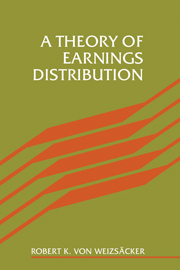Book contents
- Frontmatter
- Contents
- Preface
- Introduction: presentation of problem and overview
- 1 The general structure of the model
- 2 A life-cycle model of individual earnings
- 3 The distribution of earnings within age groups
- 4 The overall distribution of earnings
- 5 The distribution of lifetime earnings
- Selected results
- Appendix 1 Comparative static analysis of the optimal length of basic education
- Appendix 2 Comparative dynamic analysis of the optimal age–earnings profile
- Appendix 3 The distribution factors Va1, Vb, ρa1b: an illustration
- Appendix 4 Technical details for Section 3.4
- Appendix 5 Technical details for Section 4.1
- Appendix 6 Comparative static analysis of optimal lifetime earnings
- References
- Index
- Selected notation
1 - The general structure of the model
Published online by Cambridge University Press: 06 July 2010
- Frontmatter
- Contents
- Preface
- Introduction: presentation of problem and overview
- 1 The general structure of the model
- 2 A life-cycle model of individual earnings
- 3 The distribution of earnings within age groups
- 4 The overall distribution of earnings
- 5 The distribution of lifetime earnings
- Selected results
- Appendix 1 Comparative static analysis of the optimal length of basic education
- Appendix 2 Comparative dynamic analysis of the optimal age–earnings profile
- Appendix 3 The distribution factors Va1, Vb, ρa1b: an illustration
- Appendix 4 Technical details for Section 3.4
- Appendix 5 Technical details for Section 4.1
- Appendix 6 Comparative static analysis of optimal lifetime earnings
- References
- Index
- Selected notation
Summary
Stochastic models of personal income distribution: the general random walk approach
A large number of empirical studies of the distribution of earnings, i.e. individual earnings within a given economic system over a specific period (generally one year), have shown that the observed distribution can be represented by a log-normal curve as a first approximation.
Note: This is particularly true for the range of more frequently occurring earnings, i.e. the central portion of the distribution. The log-normal distribution generally provides a less satisfactory fit for the less frequent highest and lowest incomes. The upper end of the distribution, for example, is often more adequately described by Pareto's law.
Generally speaking, the literature encounters so many problems in fitting a functional form to the observed distribution that there are fundamental problems in drawing firm conclusions on the form of the distribution. These problems are partly due to the inadequate correlation between the observed data and theoretical constructions, and partly to the statistical techniques themselves.
All observed earnings distributions have certain qualitative features in common, in that they are typically:
- unimodal
- positively skewed
- showing positive kurtosis
and the log-normal distribution has all of these properties.
The further striking stability of this form of distribution has led to speculation on possible ways in which it may have come about.
One main approach employs the techniques and results of probability theory, for which reason such models are also described as stochastic.
- Type
- Chapter
- Information
- A Theory of Earnings Distribution , pp. 6 - 23Publisher: Cambridge University PressPrint publication year: 1993

